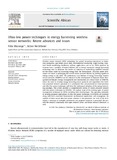Please use this identifier to cite or link to this item:
https://cris.library.msu.ac.zw//handle/11408/4106Full metadata record
| DC Field | Value | Language |
|---|---|---|
| dc.contributor.author | Mazunga, Felix | |
| dc.contributor.author | Nechibvute, Action | |
| dc.date.accessioned | 2021-05-05T10:19:18Z | |
| dc.date.available | 2021-05-05T10:19:18Z | |
| dc.date.issued | 2021 | |
| dc.identifier.issn | 24682276 | |
| dc.identifier.uri | https://www.sciencedirect.com/science/article/pii/S2468227621000247 | |
| dc.identifier.uri | http://hdl.handle.net/11408/4106 | |
| dc.description.abstract | Wireless sensor network (WSN) technology has gained increasing importance in industrial automation, agriculture, smart cities, environmental monitoring, target tracking, structural health monitoring, healthcare, military applications, and so on. WSNs powered by batteries have a problem of limited lifetime due to energy constraints. Energy harvesting technology aims to eliminate the burden of replacing or replenishing depleted batteries for the sensor nodes by harnessing energy from the environment. Ultra-low power techniques are aimed at prolonging the overall sensor network lifetime by yielding significant energy savings in the WSN. The performance and lifetime of energy harvesting wireless sensor networks (EHWSNs) can be enhanced by the development of Dynamic Power Management techniques. Energy management and conservation are critical issues in EHWSNs, hence the need to develop energy harvesting-aware protocols and algorithms that facilitate perpetual network operation. It is anticipated that advancements in miniaturization and ultra-low power techniques will drive the widespread adoption of the energy harvesting paradigm. This article provides a comprehensive review of recent advances towards ultra-low power techniques in EHWSNs. We explore some of the existing types of power management techniques in WSNs including their disadvantages. The operating principles of recently proposed applications of ultra-low power techniques in EHWSNs are reviewed along with their associated fundamental mathematical expressions and assumptions. An analysis of these recent ultra-low power schemes is also presented. For each of the techniques, a summary of strengths, weaknesses and proposed solutions is presented. We provide the research community with open research issues and future research directions as well. | en_US |
| dc.language.iso | en | en_US |
| dc.publisher | Scientific African | en_US |
| dc.relation.ispartofseries | Volume 11; | |
| dc.subject | Ultra-low power | en_US |
| dc.subject | Dynamic Power Management | en_US |
| dc.subject | Routing protocol | en_US |
| dc.subject | Wireless sensor network | en_US |
| dc.subject | Energy harvesting | en_US |
| dc.subject | Network lifetime | en_US |
| dc.title | Ultra-low power techniques in energy harvesting wireless sensor networks: recent advances and issues | en_US |
| dc.type | Article | en_US |
| item.fulltext | With Fulltext | - |
| item.openairecristype | http://purl.org/coar/resource_type/c_18cf | - |
| item.languageiso639-1 | en | - |
| item.grantfulltext | open | - |
| item.openairetype | Article | - |
| item.cerifentitytype | Publications | - |
| Appears in Collections: | Research Papers | |
Files in This Item:
| File | Description | Size | Format | |
|---|---|---|---|---|
| mazun ga.pdf | Article | 1.45 MB | Adobe PDF |  View/Open |
Page view(s)
112
checked on Apr 4, 2025
Download(s)
20
checked on Apr 4, 2025
Google ScholarTM
Check
Items in MSUIR are protected by copyright, with all rights reserved, unless otherwise indicated.



